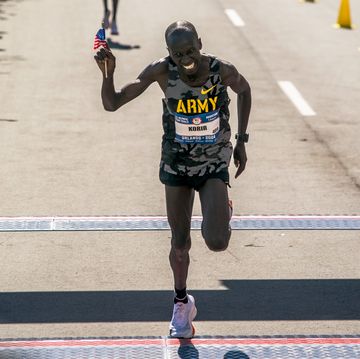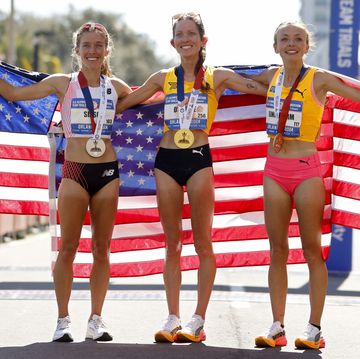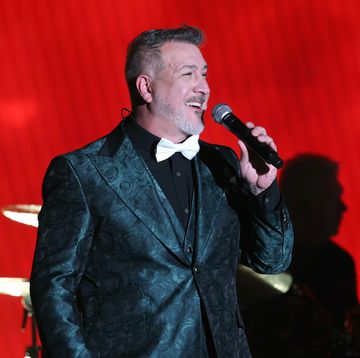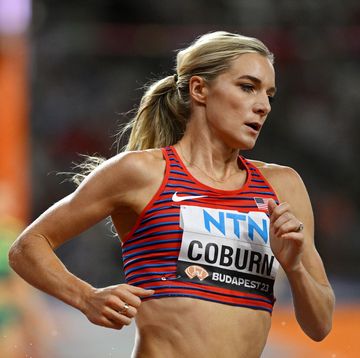Doyle Carpenter’s first job was when he was 12, as a caddy at a golf course. Too young to drive, he ran the three miles each way to and from the highway, where he hitchhiked back and forth to work.
After a stint in the Army, he spent much of his life as a bricklayer. Then, after he retired, he bought a farm in Thorn Hill, Tennessee, where he raises longhorn cattle.
Carpenter is a pretty tough guy. So in the great scheme of his life, he doesn’t consider it a big deal that, at 77, he’s winning ultramarathons.
“A lot of people, they have hip, ankle, knee problems,” he said. “But I guess I was born lined up right.”
In October, Carpenter won the Endless Mile in Alabaster, Alabama, completing 149 miles within the 48-hour time limit—in spite of cold overnight temperatures that had the race director clocking laps from inside a sleeping bag. This appears to tie the 48-hour road record for his age division set last year by a 77-year-old and recorded by the American Ultrarunning Association. That earlier performance is still awaiting official validation.
In all, Carpenter has run 130 ultras, including one in 1988 in which he did set a certified record at the time, chalking up 221 miles in 48 hours, indoors, in Pensacola, Florida. He’s also created his own: the Indian Run, a 60-mile race that includes 20 miles across Clinch Mountain in Tennessee.
Carpenter said he’s lost count of the number of marathons he’s finished, though they have included four Bostons.
“I’ve run just about all my life. It’s just something I got pretty good at,” he said. “Generally your favorite sport is what you’re the best in, and I’ve always been a good runner.”
To prepare for the ultra efforts, Carpenter averages 11 miles a day, mostly on back roads through and around his farm. He takes two days off each week.
But his day jobs have always kept him in condition. Working as a bricklayer and tending cattle—he raises longhorns to pull plows and wagons—have required their own kind of endurance. “You’re on your feet all day, in the heat,” Carpenter said. And that prepares him to deal with the elements at ultras, when younger runners try to avoid the midday heat and favor dusk and dawn.
He’s also scornful of the 5Ks and 10Ks he used to run. “It got to be more of a fashion parade, and if you got hurt, people would step over you to beat you. In an ultra, everybody’s helping one another. It’s all for one.”
His son, who’s in the National Guard, thinks he’s crazy, Carpenter said. “But he’s into CrossFit, and I think he’s crazy.”
Carpenter is part of a phenomenon of people running longer—and retaining their speed and endurance—said Hirofumi Tanaka, director of the Cardiovascular Aging Research Laboratory at the University of Texas at Austin.
“There’s no question that far more older people are participating and competing in athletic events,” Tanaka said. And because they’re staying active, he said, “their athletic performance is steadily increasing and getting closer and closer to their younger counterparts’. The older they are, the greater improvements they experience.”
That was the conclusion of a study Tanaka coauthored last year that examined 38 years of running and swimming times and found that, while winning times had not improved significantly overall, masters times quickened significantly. The older the age group, the sharper the improvement, narrowing the performance gap between older and younger athletes.
David Tosch, race director of the Endless Mile, said Carpenter is down-to-earth. “If I hadn’t known who he was, I would have just thought he was someone who came out to run around the course a few times. He’s just very modest, level-headed. And most ultrarunners are that way.”
But Carpenter has allowed himself the occasional lapse in his usual humility.
While at the Endless Mile, he said, “I was running by a couple and I heard them whispering to one another. And the woman says to this guy, ‘I bet he was a great runner when he was young.’”
Carpenter turned toward the two.
“I still am,” he said as he passed them.













